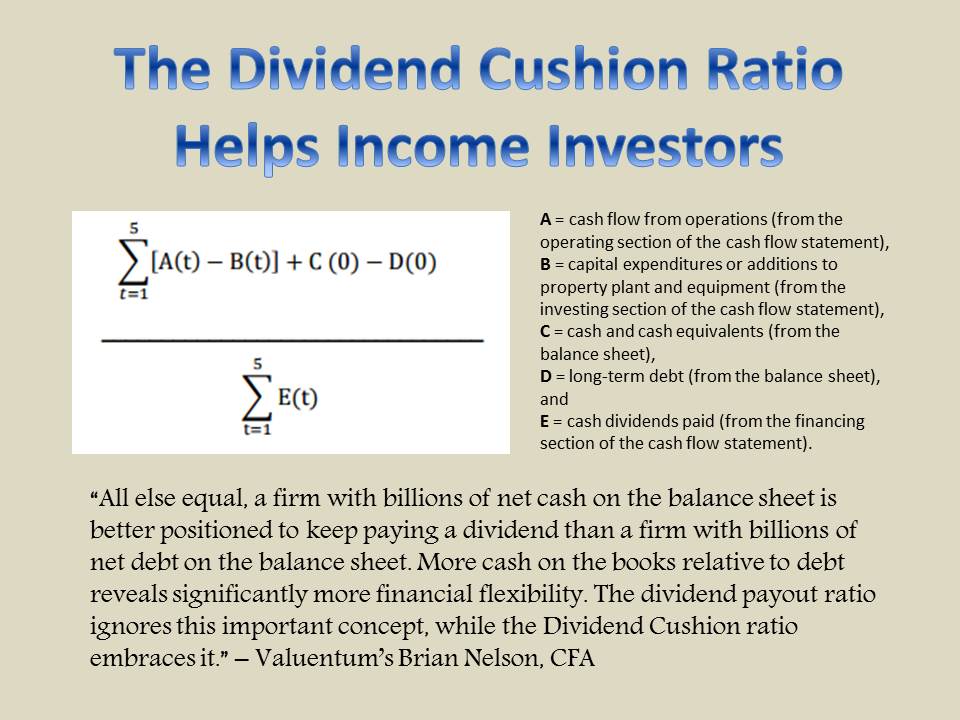Member LoginDividend CushionValue Trap |
Why Portfolio Holdings Can Sometimes Have Low VBI Ratings
publication date: Feb 3, 2016
|
author/source: Valuentum Analysts
A: This is a great question because it gives us the opportunity to explain the robustness and multi-faceted dynamics of the Valuentum Buying Index methodology. First, the Valuentum Buying Index, or the VBI, breaks down into three in-depth, standalone processes: a discounted cash-flow process, a relative value process, and a technical/momentum assessment. Each of these three pillars of the Valuentum Buying Index contain analytical insight contributing to the overall investment consideration beyond a one integer system. The combination of these three criteria results in each firm's Valuentum Buying Index rating (from 1 through 10, with 10 being the best). Each individual company report and dividend report on the website contains a wealth of analytical information, including the company's fair value estimate, fair value range, Valuentum Buying Index rating, Dividend Cushion ratio, among other items. Our team at Valuentum uses the exact reports that our members do as we manage the two newsletter portfolios. We use the Valuentum Buying Index, housed in each firm's 16-page report, as a source of idea generation. Typically, we consider adding firms to the Best Ideas Newsletter portfolio and Dividend Growth Newsletter portfolio when shares register a 9 or 10 on the Valuentum Buying Index and generally hold them until they register a 1 or 2 on the Valuentum Buying Index. We do not add every company that registers a high Valuentum Buying Index rating to the newsletter portfolios, however. Similar in thinking as if you were to imagine a value investor not adding every undervalued stock to his/her portfolio, we have a qualitative overlay, too. There are always tactical and sector weighting considerations in any portfolio construction, for one, but whereas studies suggest high-VBI-rated entities outperform low-VBI-rated entities across large sample sizes, the Best Ideas Newsletter portfolio and Dividend Growth Newsletter portfolio are much more concentrated. Any idea added to the portfolios must pass muster with the Valuentum Team. Once a company is added, at certain times during the holding period, stocks in the newsletter portfolios may register lower VBI ratings than companies outside of the portfolios. This can be confusing at times, but a lower VBI rating for a newsletter holding generally showcases something very good. In most cases, it means that shares of the company held in the portfolio have advanced to the fair value estimate, which is driving the lower VBI rating compared to the one when it was added. If the ratings of non-holdings are higher than those of newsletter portfolio holdings, but have not crossed the threshold of a 9 or 10 (the equivalent of a "we'd consider buying" rating), they have generally not met the criteria for consideration (though we may add lower-rated companies if other criteria warrants, e.g. Dividend Cushion ratio). Those that do register high ratings on the Valuentum Buying Index, however, still have to "fit" in the portfolio in the context of tactical or sector weighting considerations. If they don't, they're not added. We frequently say that our best ideas at any given time are always included in the portfolio of our Best Ideas Newsletter, and our best dividend growth ideas at any given time are always included in the portfolio of the Dividend Growth Newsletter. These are the companies that 1) have generally triggered the "consider buying" signal (a 9 or 10 on the Valuentum Buying Index) and 2) have received the thumbs-up from our team, while others have not. The goals of the two newsletter portfolios are as follows: The Best Ideas Newsletter portfolio seeks to find firms that have both good value and good momentum characteristics and typically targets capital appreciation potential over a longer-term horizon. Just like a value manager may not include every single undervalued company in the market in his/her portfolio, not all highly-rated companies on the Valuentum Buying Index are included in the Best Ideas Newsletter portfolio. We may tactically add to or trim existing positions in the portfolio on the basis of sector or broader market considerations, but we seek to capture a stock's entire pricing cycle (from being underpriced with strong momentum to being overpriced with poor momentum). The Best Ideas Newsletter portfolio puts the Valuentum Buying Index into practice. The Dividend Growth Newsletter portfolio seeks to find underpriced dividend growth gems that generate strong levels of cash flow and have pristine, fortress balance sheets, translating into excellent Valuentum Dividend Cushion ratios. Stocks in the portfolio may have lengthy dividend growth track records, but we focus most of our efforts on assessing the future safety and dividend growth potential of holdings. We continue to be flexible when it comes to striving to meet goals of the newsletter portfolios, and we may look to add certain exposure to companies that may not have the highest ratings in our coverage. For example, a deeply-undervalued company with a solid and fast-growing dividend may make the cut for inclusion into the Dividend Growth Newsletter portfolio, even if its Valuentum Buying Index rating may only be a 6, for example. Alternatively, if we're lacking preferred industry exposure (e.g. restaurants, semiconductors, or other), we may add an undervalued restaurant or chip maker to the Best Ideas Newsletter portfolio, even if its Valuentum Buying Index may only be a 7 on the scale. No matter what we do, however, we try to be as transparent as possible. There should be no surprises when it comes to the ideas we surface. Read about the importance of fair value estimates, "How Well Do Enterprise-Cash-Flow-Derived Fair Value Estimates Predict Future Stock Prices? -- And Thoughts on Behavioral Valuation."
Read about the Valuentum Buying Index rating system, "Value and Momentum Within Stocks, Too." Valuentum's Methodology Document (pdf) This article was updated December 2017. Please be sure to consult your personal financial advisor if any idea or strategy is right for you. Image Source (questions): Andrew Steele |


